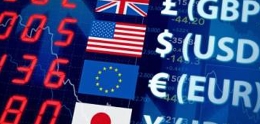What is a Currency Pair?
The first step to becoming a successful forex trader is understanding what currency pairs are and how they work. Luckily for you, you can find all that information here. This page explores how currencies work in relation to forex trading, the different types of currency pairs, and how to choose which pairs to trade.
A currency pair involves two currencies and represents the value of one currency against another. In forex trading, the changing value of a currency pair provides traders with the opportunity to make a profit.
Read on for a more in-depth look into the different types of currency pairs and to discover which currency pairs are suited to your trading style and skill level.
Currency Pairs: The Simplest Explanation You’ll Ever Get
Trading, in any respect, centers around speculating how the price of a specific asset will move. With stock market trading, for example, a trader might buy the shares of a company they believe will rise in value and then sell them at a higher price to make a profit.
The same applies to forex trading, except that you are buying a currency instead of a company share. With stocks, you are exchanging money for shares, whereas in forex trading, you are exchanging one currency for another.
The two currencies involved in this exchange are grouped into a currency pair. If you are trading EUR/USD, for example, you are exchanging euros for US dollars.
The exchange rate, or price, represents how much one currency is worth compared to the other. If the EUR/USD is trading at a price of 1.1015, that means that one euro is worth $1.1015.
Best forex brokers for trading currency pairs
How to Read a Currency Pair
Currency pairs are written in an XXX/YYY formation, with each set of three letters referring to a different currency. For instance, the EUR/USD currency pair refers to the euro and the US dollar. Some of these codes may seem obvious, but you may also come across less familiar codes, such as HUF (Hungarian Forint).
In a currency pair, the first currency is known as the base currency and the second is referred to as the quote currency. For the EUR/USD, the euro is the base currency, while the US dollar is the quote currency.
The same applies to any currency pair. With the GBP/JPY, the pound sterling is the base currency, while the Japanese yen is the quote currency.
The price of a currency pair represents the amount of quote currency you will receive for a single unit of the base currency. If the GBP/JPY, is trading at 133.073, that means you will receive 133.073 Japanese yen for one pound sterling.
Profit from Price Movement
In forex trading, you make a profit from the price movements of a currency pair. A pair will move if the base currency weakens or strengthens and/or if the quote currency strengthens or weakens.
For instance, if the euro strengthens and the US dollar remains the same, it means that one euro is worth more in US dollars. The price of the EUR/USD would, therefore, rise.
Conversely, if the US dollar strengthens while the euro remains static, the euro is worth less in US dollars. The price of the EUR/USD would, therefore, drop.
If you buy a currency pair, also known as going long or taking a long position, you are speculating that the base currency will strengthen against the quote currency. Once the price rises, you can sell it for a profit.
By selling a currency pair, also known as going short or taking a short position, you are banking on the base currency weakening against the quote currency. If you were right and the price falls, you can buy the pair for a profit.
What Is a Pip?
The change in value between two currencies is expressed through a unit of measurement known as a pip. If the EUR/USD pair was to rise from $1.1015 to $1.1016, that increase of $0.0001 represents one pip. It is usually the last decimal place in a quote.
Some brokers will offer quotes to five decimal places. This extra place is referred to as a pipette or a fractional pip. So, for instance, if the EUR/USD currency pair rose from $1.10151 to $1.10152, we would say it had moved 1 pipette or 1 tenth of a pip.
What Is a Spread?
In forex trading, every currency pair has two price quotes. These are called the bid and the ask prices. The bid is generally lower than the ask price. It represents how much of the quote currency the broker is willing to pay to buy the base currency from you. This is the price at which you will sell the base currency to the market.
The ask price represents the amount of quote currency the broker is willing to accept to sell you the base currency. In this case, you would be buying the base currency.
You’ll often see these prices listed like this:
| Symbol | Bid (Sell) | Ask (Buy) |
| EUR/USD | 1.10074 | 1.10085 |
The difference between the bid and ask price is known as the spread. In our example above, the spread is 11 pipettes or 1.1 pips.
Understanding Liquidity in the Forex Market
Liquidity is used to describe the level of activity in the financial market. It’s based on the number of active traders and the volume being traded.
The forex market is one of the most liquid financial markets in the world, with a turnover of over $5 trillion per day. However, different currency pairs have differing levels of liquidity.
Currency pairs can be split into three main categories; majors, crosses, and exotics. The majors are the most popular, which also means they tend to be more liquid than the others.
More people trade the EUR/USD and at higher volumes, for example, than the NZD/JPY. This means that the EUR/USD is more liquid than the NZD/JPY.
Types of Currency Pairs
The three main categories of currency pairs are the majors, the crosses, and the exotics.
The major currency pairs always include the US dollar and are the most liquid because they are the most traded.
Cross-currency pairs don’t include the US dollar. Crosses that involve any of the major currencies are also known as minors. The most frequently traded crosses involve the EUR, JPY, and GBP.
Exotic currency pairs consist of one major currency and one currency from an emerging market, such as Brazil, Mexico, or South Africa.
Major Currency Pairs
Major currency pairs always involve the US dollar on one side and the currency of another major economy on the other.
The reason the dollar is included in all major currency pairs is due to its unique position as the world’s reserve currency. This means that all countries, no matter what their own currency is, have stores of, and trade with, the US dollar.
These currency pairs are highly liquid. This is because of the large volumes of goods and services being traded between the countries in question. Economic and political stability also makes these currencies more appealing to forex traders, especially when the economy is going through an uncertain period.
Compared to the other categories, the majors tend to have lower spreads. Price also moves more frequently, which means more opportunities for traders to profit.
The consensus is that seven pairs make up the majors. They, along with their nicknames, are as follows:
- EUR/USD (Euro)
- GBP/USD (Cable)
- USD/JPY (Yen)
- USD/CHF (Swissy)
- USD/CAD (Loonie)
- AUD/USD (Aussie)
- NZD/USD (Kiwi)
The Euro (EUR/USD)
The EUR/USD, or the Euro, is made up of the two most popular currencies in the world. As it covers the European and United States economies, it makes up for approximately 33% of the world’s daily forex trading volume.
The high trading volume means the price is constantly moving and the moves are often significant, which means lots of trading opportunities. It also means that spreads are tighter, making scalping and similar trading styles easier.
On the other hand, the EUR/USD tends to be sensitive. A lot of institutions are involved in these two economies, any of which can affect price with a single statement. Likewise, since the European economy is made up of multiple smaller economies, economic results or announcements can affect the price.
The Cable (GBP/USD)
The Cable also has a high trading volume, with the pair accounting for approximately 8% of total forex trading. As such, it has relatively tight spreads, though they are a little wider than the EUR/USD.
While very sensitive to any news regarding the US dollar, the GBP/USD has also proven to be significantly affected by political issues in both countries.
The Yen (USD/JPY)
The Yen is also a very active currency pair in terms of trading volume. While spreads are relatively tight, it does tend to be a volatile pair. It is well-known for being stuck in a narrow range for long periods, only to then spike or crash to a new range.
The USD/JPY has also proven to be very sensitive to US interest rates. The Japanese government owns a significant number of US bonds, and any yield changes have a significant impact on their cash flow.
Cross-currency Pairs
Cross-currency pairs consist of pairs that do not involve the US dollar. Despite this, the rate of a particular cross currency pair is derived from the rates of the same currencies against the US dollar.
In other words, the GBP/JPY rate is dictated by the rate of the GBP/USD and the USD/JPY. If the GBP/USD is trading at $1.25 (or approximately £0.8 to $1) and the USD/JPY is trading at ¥107.5, then the GBP/JPY will be calculated as ¥107.5 to £0.8 or approximately ¥134.4 to £1.
While not as frequently traded as the majors, these currency pairs are still sufficiently liquid to provide lots of trading opportunities. Spreads, however, tend to be wider.
Some of the more popular crosses (along with their nicknames) include:
- EUR/GBP (euro pound or ‘Chunnel’)
- EUR/JPY (euro yen or ‘Yuppy’)
- GBP/CHF (pound Swissy)
- GBP/JPY (pound yen or ‘Guppy’)
- GBP/AUD (pound Aussie)
- EUR/CAD (euro Loonie)
- NZD/JPY (Kiwi yen)
Direct trading of cross-currency pairs accounts for approximately 7% of the global currency trading volume. However, this figure is not entirely accurate since the large trades conducted by banks of these currency pairs go through the US dollar.
The Chunnel (EUR/GBP) and other euro crosses
The Chunnel, like other EUR crosses, generates relatively small daily movements in terms of overall pips. The average is approximately 20 to 40 pips.
When it comes to Euro crosses, the direction tends to be determined by Eurozone economic results relative to the Swiss or UK economies. News from the UK, for example, will affect the EUR/GBP and the GBP/USD, but Eurozone data will have a greater effect on euro crosses than on the EUR/USD.
The Yuppy (EUR/JPY) and other yen crosses
The Yuppy generates the largest trading volume of all the yen crosses. However, this currency pair is heavily influenced by risk sentiment and can, therefore, be prone to quick, large movements.
The Yuppy, like all crosses, is influenced by the underlying USD pairs. However, while the EUR/USD does have some impact, the USD/JPY seems to be a key driver due to its volatile tendency.
Attempting to determine which underlying currency pair will drive the EUR/JPY, though, poses a significant risk and shouldn’t be attempted by a beginner.
Exotic Currency Pairs
Exotic currency pairs involve the US dollar on one side and the currency of an emerging economy on the other, such as Brazil, Mexico, South Africa, and Thailand. Trading exotic currency pairs is considered to be riskier than trading the majors or cross-currency pairs, as price movements can be choppy due to the lower liquidity.
Due to the overall lower degree of liquidity, exotic currency pairs tend to be far more sensitive to political, economic, and social events. A local political scandal or national elections, for example, can cause immediate and significant movements.
Some examples of exotic currency pairs include:
- USD/BRL (dollar real)
- USD/ZAR (dollar rand)
- USD/MEX (dollar mex)
- USD/THB (dollar baht)
The Dollar Real (USD/BRL)
Like many other currencies from emerging markets, there is always a significant risk in trading them. Currency manipulation, social unrest, and political problems are all issues that can arise unexpectedly.
For example, in 2012, the Brazilian government took direct action to depreciate the real against the US dollar, which led to a drop of 10%. In other words, trading exotic currencies is not for beginners because your analysis can easily be compromised by unforeseen events.
What Are the Best Currency Pairs to Trade?
The best currency pairs to trade, especially for beginners, are the majors. Compared to cross-currency and exotics pairs, their movements are somewhat more predictable.
With the majors, you don’t have to try to guess which side of the pair will have a greater impact, which can be the case when trading cross-currency pairs. You also don’t run the risk of waking up and finding that a revolution has started somewhere, and so now your analysis is nowhere near in line with what’s happening, like with the exotics.
Consider these key points when considering trading the three most popular currency pairs:
- The EUR/USD has the tightest spread and is relatively stable, which means a lower degree of risk.
- The USD/GBP is somewhat more volatile than the EUR/USD, but the profit per pip is also higher.
- The USD/JPY is also a good pair to trade thanks to low spreads and high liquidity.
Although trading major currency pairs is generally less risky than trading other types of pairs, you can still lose money just as easily if you don’t know what you’re doing. The key to trading any currency pair successfully is to meticulously study its movements and the reasons behind them.
Each pair has its own quirks that you will only become familiar with through practice. Most successful traders advise beginners to start with one pair and focus on that pair until you know it inside out.
Now that you understand what exactly currency pairs are and how they work, you’re all set to dive deeper and look at how to set up a currency pair trade on a popular trading platform like MetaTrader 4.
Frequently asked questions (FAQ)
Other educational materials
- Majors and Crosses – How to Trade Them?
- Leverage and Margin Requirements
- What is a Margin Call?
- Setting Up a Chart in Metatrader 4
- Forex Trading Accounts and the Value of a Pip
Recommended further readings
- What are Currency Pairs and the Basics of Currency Trading
- The euro as an international currency: explaining puzzling first evidence from the foreign exchange markets. Hau, H., Killeen, W., & Moore, M. (2002). Journal of International Money and Finance, 21(3), 351-383.










